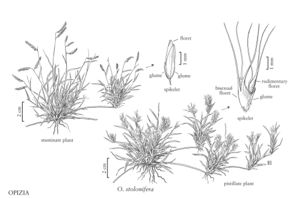| Taxon | Illustrator ⠉ | |
|---|---|---|
 | Opizia stolonifera | Karen Klitz Linda A. Vorobik |
Plants annual, perennial, or of indefinite duration; monoecious or dioecious, inflorescences unisexual and dimorphic; stoloniferous and mat-forming. Culms 1-15 (30) cm, not woody. Leaves not clustered, not strongly distichous; sheaths open, keeled; ligules membranous, not ciliate; blades flat. Inflorescences terminal, with spikes or spikelike branches on elongate rachises. Staminate inflorescences panicles of 1-6 spikelike pectinate branches on elongate rachises, exserted well above the uppermost leaves; branches 0.5-2 cm, terminating in a point; staminate spikelets glabrous, with 1 floret; glumes unequal, much shorter than the the florets; lemmas 3-veined, unawned. Pistillate inflorescences 1-sided spikes, with 6-12 spikelets, often partially enclosed by the subtending sheaths, sometimes with branches to 6 mm long at the lower nodes; disarticulation below the glumes, the spikelets falling intact; pistillate spikelets laterally compressed, with 1 bisexual floret and a conspicuously 3-awned rudiment; lower glumes rudimentary or absent; upper glumes subequal to the lemmas, membranous, flat, not enclosing the florets, unawned; calluses blunt, with hairs; lemmas coriaceous, keeled, 3-veined, 3-awned, awns emanating from between 4 short, hyaline teeth; palea keels adnate to the rachilla basally, widely winged distally. x = unknown.
Discussion
Opizia is a North America genus of two species. Both species are probably native to Mexico, but one of them now grows, possibly from introductions, in Florida and the West Indies.
Columbus (1999) argued that Opizia should be included in Bouteloua. The traditional treatment is maintained here, pending corroboration of his results from a wider range of data.
Selected References
Lower Taxa
"decumbent" is not a number.